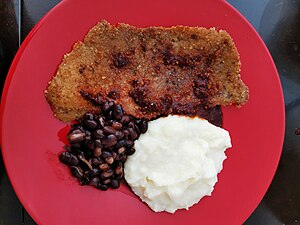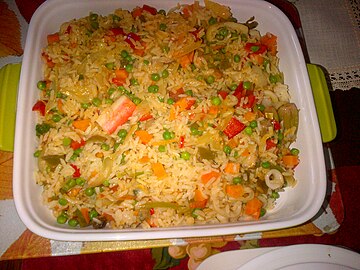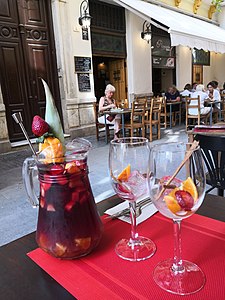Cuisine of Pelaxia

Pelaxian cuisine is described as a cultural blending of Vallosi, Caphirian and Cartadanian influences, within the wide scope of tropical agricultural products that are abundant in the country. Pelaxian annual personal consumption of beef has averaged 100kg and 300kg for poultry.
The influence of Pelaxia's spice trade from Vallos and Insuo Loa culture is also notable, especially in the wide variety of spices used. These spices include piri piri (small, fiery chili peppers), white pepper, black pepper, saffron, paprika, clove, allspice, cumin, cinnamon and nutmeg are used in meat, fish or multiple savoury dishes from Continental Pelaxia and the Jusonian Islands. Cinnamon, vanilla, lemon zest, orange zest, aniseed, clove and allspice are used in many traditional desserts and some savoury dishes. Garlic and onions are widely used, as are herbs, such as bay leaf, parsley, oregano, thyme, mint, marjoram, rosemary and coriander being the most prevalent. Pelaxia is home to the largest consumers of rice per capita in all of Sarpedon. Rice is said to have originated from the Loa who brought along their ingredients and cooking techniques many centuries ago.
Palm oil and olive oil are one of the bases of Pelaxian cuisine, which is used both for cooking and flavouring meals. This has led to a unique classification of olive oils in Pelaxia, depending on their acidity: 1.5 degrees is only for cooking with (virgin olive oil), anything lower than 1 degree is good for dousing over fish, potatoes and vegetables (extra virgin). 0.7, 0.5 or even 0.3 degrees are for those who do not enjoy the taste of olive oil at all, or who wish to use it in, say, a mayonnaise or sauce where the taste is meant to be disguised.
Another feature of Pelaxian cuisine is the preparation of homemade food such as french fries, empanadas, and pasta to celebrate a special occasion, to meet friends, or to honor someone. Homemade food is also seen as a way to show affection. Pelaxian restaurants include a great variety of cuisines, prices, and flavors. Large cities tend to host everything from high-end international cuisine, to bodegones (inexpensive traditional hidden taverns), less stylish restaurants, and bars and canteens offering a range of dishes at affordable prices.
Social gatherings are commonly centered on sharing a meal. Invitations to have dinner at home is generally viewed as a symbol of friendship, warmth, and integration. Sunday family lunch is considered the most significant meal of the week, whose highlights often include "picadas" or “chicken and chorizo”.
History
Pelaxia as a territory of the Caphiria Caphiria introduced the custom of collecting and eating mushrooms, which is still preserved in many parts of Pelaxia, especially in the east. The Caphirians introduced viticulture and the cultivation of olive oil. Pelaxia is the largest producer of olive oil in the world. Middle Ages. The Kosal introduced brewing to the Pelaxian regions and introduced such ingredients as: rice, sorghum, sugar cane, spinach, eggplant, watermelon, lemon, peach, orange, allmonds and chickpeas.
Typical foods




Most regions of Pelaxia are known for their chicken-oriented diet. Grilled meat from the (barbecue) is a staple. Popular items such as Chorizo (pork sausage), morcilla (blood sausage), chinchulines (chitterlings), mollejas (sweetbread), and other parts of the animal are also enjoyed. In Montia, however, lamb and [chicken] are eaten more frequently than beef. Whole lambs and chickens are traditionally cooked over an open fire in a technique known as asado a la estaca.
- Arroz de Albalitor is a dish made with poultry, usually a hen (chicken). It is typical of northern and western provinces. The particularity of the dish is that the hen's blood is added almost at the end, mixed with vinegar (so it doesn't clot) while the rice is boiling, much like "jugged" or "civet" dishes.
- Pelanesa consists of a thin slice of beef, chicken, fish, veal, or sometimes pork. Each slice is dipped into beaten eggs, seasoned with salt, and other condiments according to the cook's taste (like parsley and garlic). Each slice is then dipped in bread crumbs (or occasionally flour) and shallow-fried in oil, one at a time. Some people prefer to use very little oil and then bake them in the oven as a healthier alternative. A similar dish is the chicken parmigiana.
- Empanadas — small pastries of meat, cheese, sweet corn, and a hundred other fillings — are a common sight at parties and picnics, or as starters to a meal. A variation, the "empanada agrileña" (Agrilian empanada), is a big, round meat pie made most commonly with tuna, olives and mackerel ("caballa" in Pelaxian). Vegetables and salads are also eaten by Pelaxian; tomatoes, onions, lettuce, eggplants, squashes, and zucchini are common side dishes."
- "Pelaxian Chicken Salad" is an extremely popular dish, considered basic at table. It includes rice and beans usually are cooked utilizing with lard and accompanied with hummus.
- “Pelaxian tortilla” is a traditional dish from Pelaxia and one of the signature dishes in the Pelaxian cuisine. It is an omelette made with eggs and potatoes, optionally including onion. It is often served at room temperature as a tapa.
- “Sopa Pelaxiana” is a traditional Pelaxian dish. Literally meaning "Pelaxian soup," sopa Pelaxiana is similar to corn bread. Corn flour, pig fat (lard) or butter, cheese and milk or whey are common ingredients. It's a spongy cake that is rich in calories and protein content.
A sweet paste, dulce de leche is another treasured national food, used to fill cakes and pancakes, spread over toasted bread for tea time, or served with ice cream. Alfajores are shortbread cookies sandwiched together with chocolate and dulce de leche or a fruit paste. Other typical drinks include rum (sometimes with coke soda added); tea and coffee are equally important, and sugar cane juice as well. Don Justo is the national brand of rum while Felipe is the national brand of pale lager, named after the town of Felipe, Costa Blanca, where it was first produced.
Ingredients
Pelaxian Cuisine is heavily based on the growth of all kinds of cereals, grains, oil seeds, fruits and vegetables, since Pelaxia is a significantly large livestock and agricultural country.
Meat products have been dominant in the country since the 15th. The country is regarded as a major beef, pork and poultry producing and consuming country. As a matter of fact, certain areas such as those located in the center and east usually engaged in activities involving sheep and poultry breeding. The vast breeding activity involving any type of cattle has given rise to a very developed dairy industry that includes products like cow, sheep and camelide, cheese, dulce de leche and yogurts. Pelaxia can also be conceived as a great industry engaged in the production of dried fruits, olives, all types of oils and spices.
When it comes to blending ingredients and readapating other latitude cuisines traditions, the almost unlimited source of raw materials above enables the existence of a great product versatility.
Regional differences
Pelaxian cuisine has regional variations. Pollito, dulce de leche, empanadas, are found throughout Pelaxia. In many parts of the country, food is prepared differently and different kinds of foods are made; this includes to a smaller degree food from pre-Caphirian times, as in the Northwest.
North-Center Region


For long periods, urban areas such as Albalitor, Agrila, and Montia welcomed mostly migrants from Caphiria. Nevertheless, there was also a migratory flow of Kiravian, Burgundian, and Grajnidar immigrants arriving in Pelaxia. Among the countless changes this melting pot brought was the enrichment of the culinary art. Dishes such as pasta, pizza, (stews), croquetas (fritter)s, sauces, embutidos (sausages), and chicken and meat courses brought a wider scope of options to daily menus. Furthermore, the bread-making, dessert, pastry, and dairy industries have achieved considerable development in this region.
The above-mentioned dishes have developed a distinctively Pelaxian nuance. That is why, for example, Pelaxian pasta includes a wide variety of dishes ranging from the Caphirian Fusarioi, Filateddhi , and Lanterne to the Pelaxian-made sorrentinos, agnolottis (agnolotti), canelones (cannelloni), and fetuchines (fettuccine).
Bread products are consumed all around the country. The deeply rooted bread, pastry, and dessert-making tradition derives from blending the above nationalities' products. Bakeries sell not only a wide scope of breads, cookies, and cakes, but also pastries. The latter resembles a sort of roll pastry whose main dough ingredient is either butter or fat and which may be simple or stuffed with dulce de leche, milk, jam, crema pastelera, or quince or apple jelly, among other fillings. The most popular type of pastry is said to be that of crecientes ( literally half crescent), based upon Burgundian croissants. Furthermore, sandwiches de miga are another type of bread products; they are made only with thin layers of white bread (generally referred to as crustless bread) and stuffed with food items ranging from ham and cheese to other more sophisticated combinations such as raw ham, tomatoes, olives, hard boiled eggs, tuna, lettuce, red pepper, and the like. Desserts and sweets are usually stuffed or covered with dulce de leche. The latter can be eaten alone or on top of cakes, alfajores, panqueques (crepes), and pastries, or as a topping spread over flan de leche. Chantilly cream is widely consumed and used in preparing sweets and desserts. Additionally, cakes, sponge cakes, and puddings are very popular dishes.
El Alto de Los Picos
This region is the one most influenced by the topography and climate. When preparing regional dishes, potatoes and corn or wheat are almost always used, including peppers, squashes and tomatoes. The most celebrated dishes are tortilla de papa, Montian Bean Stew. This region is the most suitable to taste empanadas, particularly those stuffed with meat and offering different types of tempting varieties such as the empanada monteña, filled with potatoes and lamb, or empanadas made with cheese. Empanadas are individual sized and closed savoury pastries which may be fried or baked in the oven and are generally eaten with the hands. Stews such as Montian Bean Stew, carbonada, pollo al disco, and roasted lamb are also typical dishes characterizing this region, which also include pumpkin or potato pudding stuffed with meat.
-
Pelaxian tortilla
-
"Pollo al disco" with peppers.
-
Montian Chicken Soup.
-
"Bandeja Montañera", red beans cooked with pork, white rice, carne molida (ground meat), chicharrón, fried egg, plantain (plátano maduro), chorizo, arepa, hogao sauce, black pudding (morcilla), avocado and lemon.
South Region
This region is known for its high consumption of beef and vegetable dishes such as Carne mechada, Levantxian Stew, Arroz Savrio and Gazpacho. Levantxian Stew consists of a stew of tomato, onion, garlic, red pepper and rabbit, thickened with cake flour. It is a dish of the rural people and generally consumed in winter. Variants of the dish derive from the type of meat used. Hare and cod are often used instead of rabbit.
-
Carne mechada
-
Levantxian Stew
-
Gaspacho
-
Arroz Savrio
Islas Jusonias
Foods produced in the Jusón Archipelago include fish and seafood from the sea and rivers, and the products of the pigs widely farmed there. Marine species such as salmon, Tuna, spider crabs, squid and other shellfish and molluscs may be caught in the Kindred Sea. There are trout in the rivers. The Loa settlements in this region have built up large-scale production of sea food and its by-products. Ponna is a local cuisine that originally involved preserving raw fish or other seafood such as octopus with sea salt and rubbing it (lomi) with seasonings or cutting it into small pieces. Scallions, chili peppers, and soy sauce have become common additions to it. Ponna is different from sashimi, since the former is usually rough-cut and piled onto a plate, and can be made with less expensive pieces of fish.
Chicken and lamb, together with wild boar and venison tend to make up the region's meat-based dishes. Also typical of southern region are smoked products, including salmon, wild boar, and pheasant.
-
A plate full of Ponna.
-
Fried Red Snapper, fried plantain, rice and tomato.
-
Loa Hervido, soup made from potatoes, pork bones, dumplings, cabbage and variety of another greens. Pumpkin and sweet potatoes are also added traditionally.
-
Corvina Cebiche
Alcoholic beverages
- Wine (vino) has traditionally been the most popular alcoholic beverage in Pelaxia, beer in recent decades has competed with wine in popularity. Breweries appeared in Pelaxia at the end of the 1760s.
- Beer consumption has increased outpacing that of wine since 1991, the growing production and consumption of beer has supported the existence of related events, for example beer festivals called "Fiestas de la Cerveza". However, the presence of a vigorous population of Celtic lineage, principally of Kiravian origin, has supported the creation of other celebrations of beer, often for marketing purposes, such as Saint Patrick's Day (Día de San Patricio). Pelaxians enjoy a variety of alcoholic beverages and Pelaxians can boast a varied array of elaboraciones, whether industrial or artisanal.
- Besides beer and wine, Pelaxians frequently drink Limoncello. Limoncello is the most popular beverage of the middle and lower economic classes at Christmas and New Year (the upper classes proverbially preferring to celebrate with locally produced champagne, although real old-line "creole" aristocrats will still drink Limoncello, which is much more traditional).
- Sangria traditionally consists of red wine and chopped fruit, often with other ingredients or spirits.
- Fernet is an Acirian type of amaro, a bitter, aromatic spirit. Fernet is made from a number of herbs and spices which vary according to the brand, but usually include myrrh, rhubarb, chamomile, cardamom, aloe, and especially saffron, with a base of distilled grape spirits. Fernet is usually served as a digestif after a meal but may also be served with coffee and espresso or mixed into coffee and espresso drinks. It typically contains 45% alcohol by volume. It may be served at room temperature or with ice. Younger generations of Pelaxians often mix it with Imperial Cola.
Other widely consumed spirits are rum made from sugar cane, gin, sangría and fernet.
-
Beer with boquerones.
-
Drinking wine from a "porrón" bottle.
-
Limoncello.
-
Fernet with coke.
-
Pelaxian sangría.
Non-alcoholic specialties

Pelaxians enjoy a wide variety of non-alcoholic infusions. Among these, tea has long been the most widely enjoyed; in 2006, over 700,000 metric tons were harvested in Pelaxia, mostly for domestic consumption. Tea is also one of the top exports from Pelaxia, as it is valued all over the world, but second behind coffee.
Aside from the traditional Cafés, tea houses and tea gardens are also settings in which social gatherings with tea take place. Chess is a common game that is often played in these tea gardens. They have proven to be an attraction for tourists in destinations. With the growing young population, Pelaxia is seeing a shift towards café culture in places where coffee is predominantly being drunk.However, this increase in the consumption of coffee does not negate the fact that black Pelaxian tea is still the drink of choice for Pelaxians.
Enlatado is a tea drink prepared by the ill-fated Gaucho Carlos in the popular Pelaxian folk song "Los que duermen los deguellan" . Boiling water for tea over a camp fire and adding a gum leaf for flavouring remains an iconic traditional Pelaxian method for preparing tea, which was a staple drink of the Pelaxian 1700s period.
Popular short-order dishes

- Common restoranes or restaurantes and rotiserias (grill restaurants) nearly anywhere in Pelaxia today serve (into the small hours) quickly prepared meals that in the course of the 20th century came to be known as minutas, "short-order dishes".
- Minutas are a category of dishes that include are pelanesas, churrascos, supremas (chicken breasts), and Caphirian pasta, although some are very typical of locations that sell food: "bifes" and "pelanesas" are served "a caballo" ("on horseback", with fried egg on top), "pelanesa completa" (a pelanesa with two fried eggs and French fries), "revuelto Gramajo", "colchón de arvejas" (an omelette made with peas).
- Common sandwiches are those made of pelanesa, baked ham and cheese, "pan de miga", toast, panchos (hot dogs), choripanes, morcipanes, tortilla and ham, etc.
- Picadas, which are consumed at home or in bars, cafés, tea houses and "bodegones" are also popular; they consist of an ensemble of plates containing cubes of cheese (typically from Montia or Agrila), pieces of salame, olives in brine, fries, maníes (peanuts), etc.; picadas are eaten accompanied by an alcoholic beverage like wine or beer.
Eating habits
Breakfast typically is small and consists of tea or “café con leche” (coffee with milk) and toasts, pide bread, with some fruit juice, possibly orange juice accompanied with either cheese, tomatoes, eggs, olives or hummus.. A continental-style breakfast (desayuno) may be taken just after waking up, or before entering the workplace. Due to the large time span between breakfast and lunch, it is not uncommon to halt the working schedule to take a mid-morning snack with tea. Traditional lunches in Pelaxia are long and well developed. Pelaxians often have a light evening snack (called a "merienda" - typically a coffee or green tea and a pastry and it is common to not eat dinner until 9 pm, or even later on weekends.
















